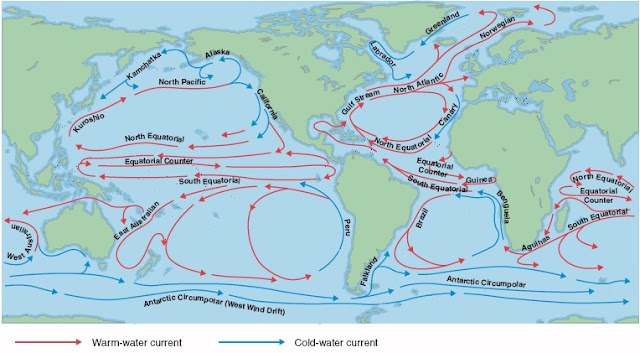Ocean
Currents: Ocean
currents are large masses of surface water that circulate in regular patterns
around the oceans, e.g.. the North Atlantic Drift, Labrador Current, Benguela
Current, etc.
Based
on temperature. Ocean currents can broadly be divided into two classes—the warm
and the cold currents.
The
Warm Currents: These are those currents which flow
from the low latitudes in Tropical Zones towards the high latitudes in the
Temperate and Sub-polar Zones. They bring warm water into cold water areas.
The
Cold Currents: These currents have a lower surface
temperature and bring cold water into warm water areas. These currents flow in
the high latitudes from the Polar regions towards the low latitudes in the warm
Equator region.
Based
on their depth the ocean currents can also be divided into two categories:
The
Surface Currents: These currents constitute about 10 per
cent of all the water in the ocean, these waters are the upper 400 m of the
ocean.
The Deep Water Currents: These currents make up the other 90
per cent of the ocean water. These waters move around the ocean basins due to
variations in the density and gravity. Deep waters sinks into the deep ocean
basins at high latitudes, where the temperatures arc cold enough to cause the
density to increase.
Causes
of Ocean Currents: The ocean currents have a circulation of water
in a regular pattern around the oceans. The origin and nature of the movement
of the currents arc related to the following factors:
(i) Level
of Salinity: The higher the level of salinity of ocean water, the denser it
is. Water with less salinity therefore flows, over the denser saline water. For
example the Mediterranean Sea is more saline as compared to the Atlantic Ocean:
so the Atlantic water flows into Mediterranean Sea's surface.
(ii) Temperature:
The oceans near the tropics and Equator are much warmer than the ocean water in
the polar or temperate regions. Therefore warm Equatorial water move towards
poles as warm currents, while cold ocean currents move towards Equator as cold
ocean currents.
(ill) The Earth s Rotation: Since the speed
of rotation of the earth is maximum at the Equator, all moving bodies (winds
and ocean currents) move in a clockwise direction in the Northern Hemisphere
and anticlockwise direction In the Southern Hemisphere, e.g. Canary current and
Gulf stream in Northern hemisphere and Peruvian and West Wind Drift in Southern
hemisphere.
(iv) The Planetary Winds: The
planetary winds play a dominant role on the flow of ocean currents.
(a) Trade
Winds : Trade Winds blow between the Equator and the Tropics. These winds
move Equatorial waters polewards and westwards. They warm the eastern coasts of
continents. For example:
(i) The North-East Trade Winds move the
North Equatorial Current to warm the eastern coasts of Japan as the Kuroshio
Current.
(ii) The South-East Trade Winds drive the
South Equatorial Current which warms the eastern coast of Australia as the warm
East Australian Current.
(b) Westerlies:
Westerlies blow in the temperate latitudes and result in a north-easterly flow
of water in the Northern Hemisphere and the opposite In the Southern
Hemisphere. For example:
(i) The Westerlies force the warm Gulf
Stream to the western coast of Europe as the North Atlantic Drift.
(ii) They cause the cold West Wind Drift
to flow towards the Equator as the Peru Current along South America and the
Benguela Current along South Africa.
(c)
Monsoon Winds: The strongest influence of prevailing winds on flow of current is
seen in the North Indian Ocean. Due to the monsoon winds the direction of the
currents change from south-west in summer to the north-east in winter.
(v)
Land : A land mass obstructs the flow of water of an ocean current and
diverts its movement. For example, at Cape Sao Roque the South Equatorial
Current gets divided into two branches, one Joins North Equatorial current, the
other becomes the Brazil current.
CIRCULATION
PATTERN OF OCEAN CURRENTS
Ocean
currents are greatly influenced by the stresses exerted by the prevailing winds
and Coriolis force. The oceanic circulation pattern roughly corresponds to the
Earth's atmospheric circulation pattern. The air circulation over the oceans in
the middle latitudes Is mainly anti-cyclonic (more pronounced in the southern
hemi-sphere than in the northern hemisphere). The oceanic circulation pattern
also corresponds with the same. At higher latitudes, where the wind flow is
mostly cyclonic, the oceanic circulation follows this pattern. In regions of
pronounced monsoonal flow, the current movements are influenced by the monsoon
winds. Due to the Coriolis force, the warm currents flow from low latitudes to
move to the right in the northern hemisphere and to their left in the southern
hemisphere. The cold waters of the Arctic and Antarctic circles move towards
warmer water in tropical and equatorial regions, while the warm waters of the
lower latitudes move pole wards.
Advertisements


No comments:
Post a Comment